Build Landscape Chart
Build Landscape Chart
In Prolaborate, users can build Landscape charts by any one of the following methods.
- Build Landscape Pie Chart using Designer Configuration
- Build Landscape Pie Chart using SQL Queries
- Build Landscape Pie Chart using Reports
Build Landscape Chart using Designer Configuration
Chart designer allows users to create charts with few simple clicks. With a chart designer, charts can be configured by simply selecting the filters. A MDG based sub-report can be added as well to see detailed information by clicking the dissections of the chart.
Chart designer allows users to view the query that was generated by the configurations made, which can be further be edited to create customized charts if required.
In Create Chart Widget, follow the below steps to create a Landscape using designer configuration.
Basic Details
| Field | Description |
|---|---|
| Chart Name | Enter a suitable chart name |
| Choose Chart Type | Choose Landscape under chart type |
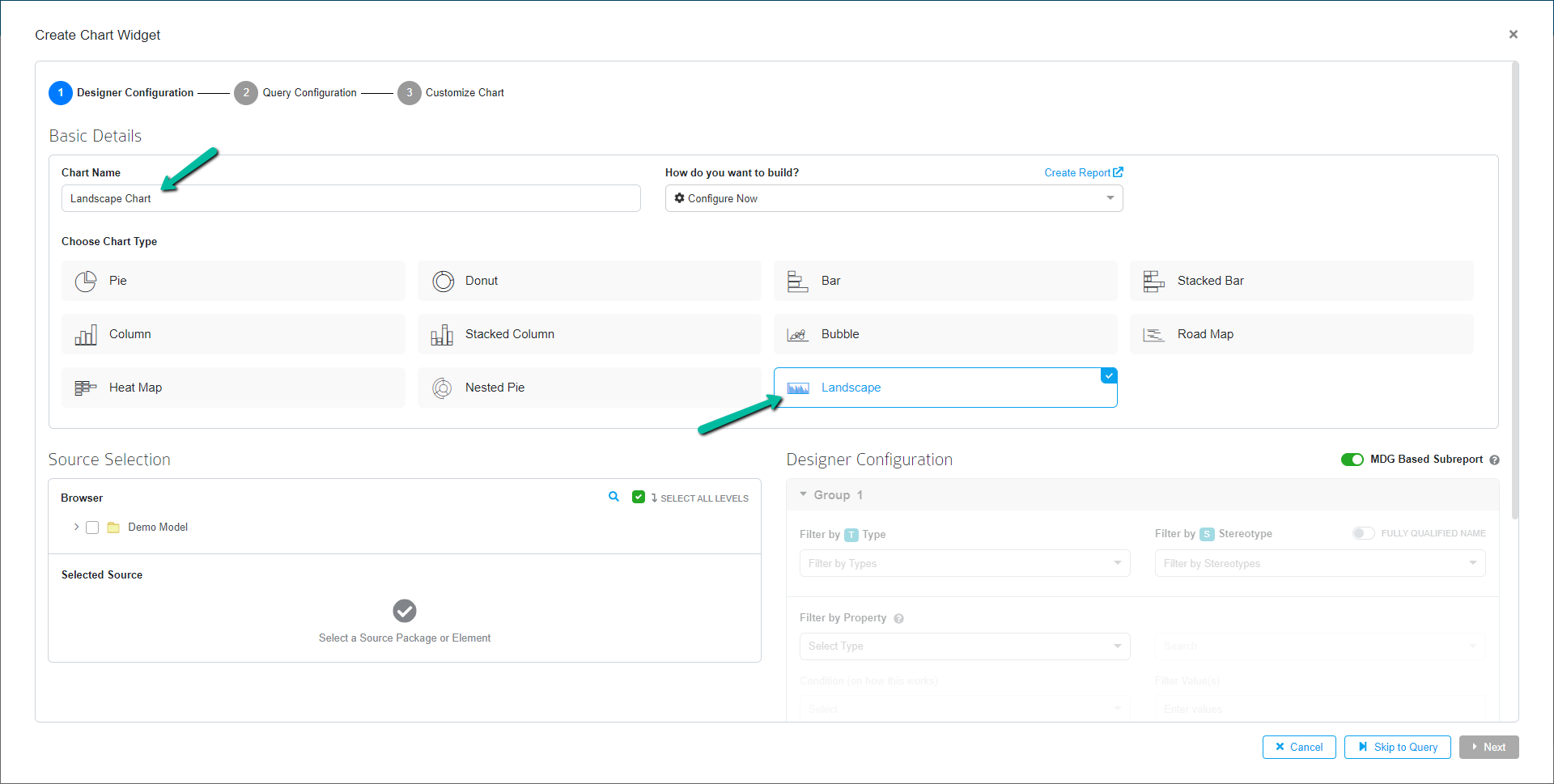
Source Selection
| Field | Description |
|---|---|
| Browser | By clicking on this section, you will be able to view the package |
| Search Repository | To search for packages and elements. Click the Search icon to open the repository search page, where the user can search for elements by name, or the user can choose object type, type, and stereotype from the dropdown menu |
| Select All Levels | When Select All Levels is selected, the sub packages and elements within a package are selected automatically once the user selects the package |
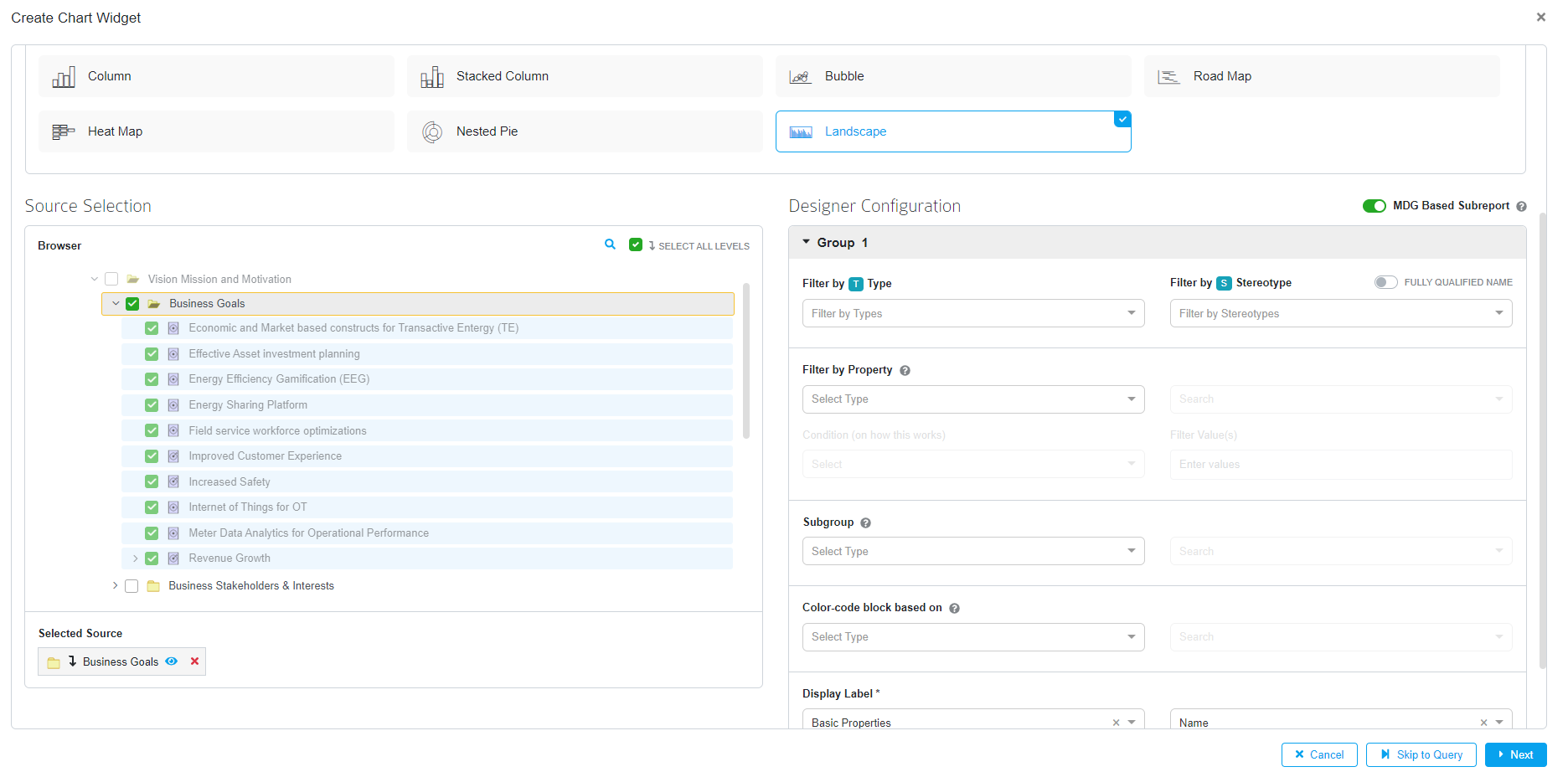
Designer Configuration
This section allows the user to select the configuration needed to create a chart.
| Field | Description |
|---|---|
| MDG Based Subreport | Option enabled by default which allows users to see in-depth information when one clicks the dissections of the chart. It also allows users to filter the report data based on MDG stereotypes available. To know more click here |
| Filter by Type | Select the Object type from the dropdown that is available from the package |
| Filter by Stereotype | Select the stereotype from the dropdown |
| Fully Qualified Name | By enabling this option, one can see the complete name of the Stereotype with its technology. If not enabled, you will be able to see only the name of the Stereotype |
| Filter By Property | You can filter the elements based on the basic properties i.e., Name, Stereotype, Status, Notes, etc, or tagged values Condition (on how this works): User can filter based on the conditions like IN, NOT IN from the tagged value and Basic Properties Filter values: Based on the above Tagged value or Basic Property, user can filter in detail by using the values from the Tagged value or basic property |
| Subgroup | Results of level 1 will be grouped based on the selection (basic properties or tagged value) |
| Color-code section based on | Sections will be color coded based on values of basic properties or tagged values selected. Colors will be applied to the chart either from Color Palette or MDG Color Configuration |
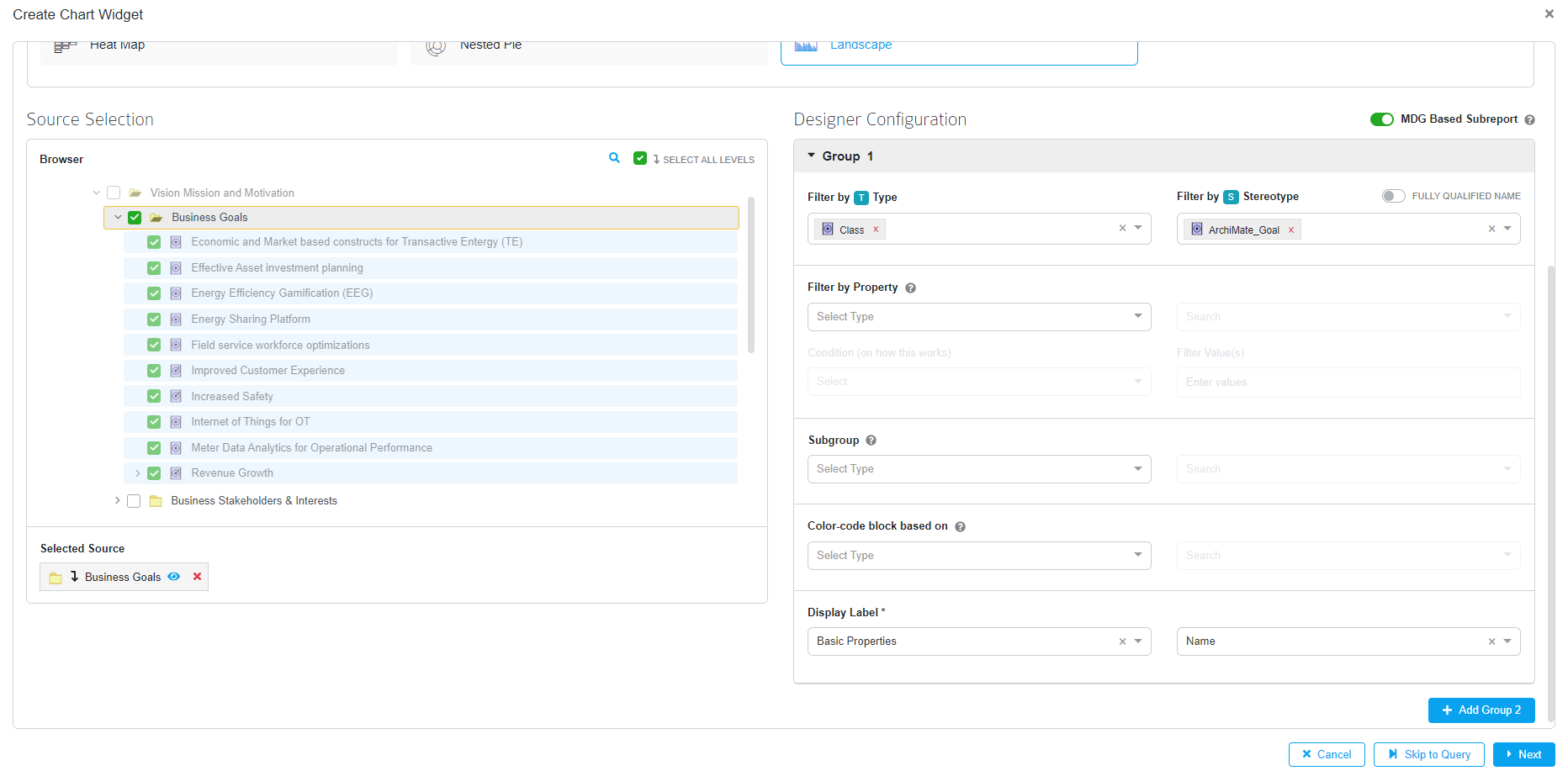
Click Add Group 2 to add the next level if required.
| Field | Description |
|---|---|
| Choose connector direction | Choose the required connector direction from the dropdown |
| Choose Connector Type | It lists all the connector type from the elements filtered from level 1 and the connector direction shown in level 2. Choose the required connector type from the dropdown |
| Choose Connector Stereotype | Choose the required connector stereotype displayed based on the previous configurations from the dropdown |
| Show on Chart | Toggle this option to show/hide the level configured in the final output of the chart. This would come in handy when building charts with many levels and you want to control which levels need to be displayed |
| Delete | Click Delete icon to delete the level from the chart |
Once the connector type or stereotype is selected, element filters and color code options are displayed. Configure them and follow the same steps to add the third level, if required.
Note:
- No more than three levels can be added to a multi-level chart (Heat Map, Nested Pie, Landscape)
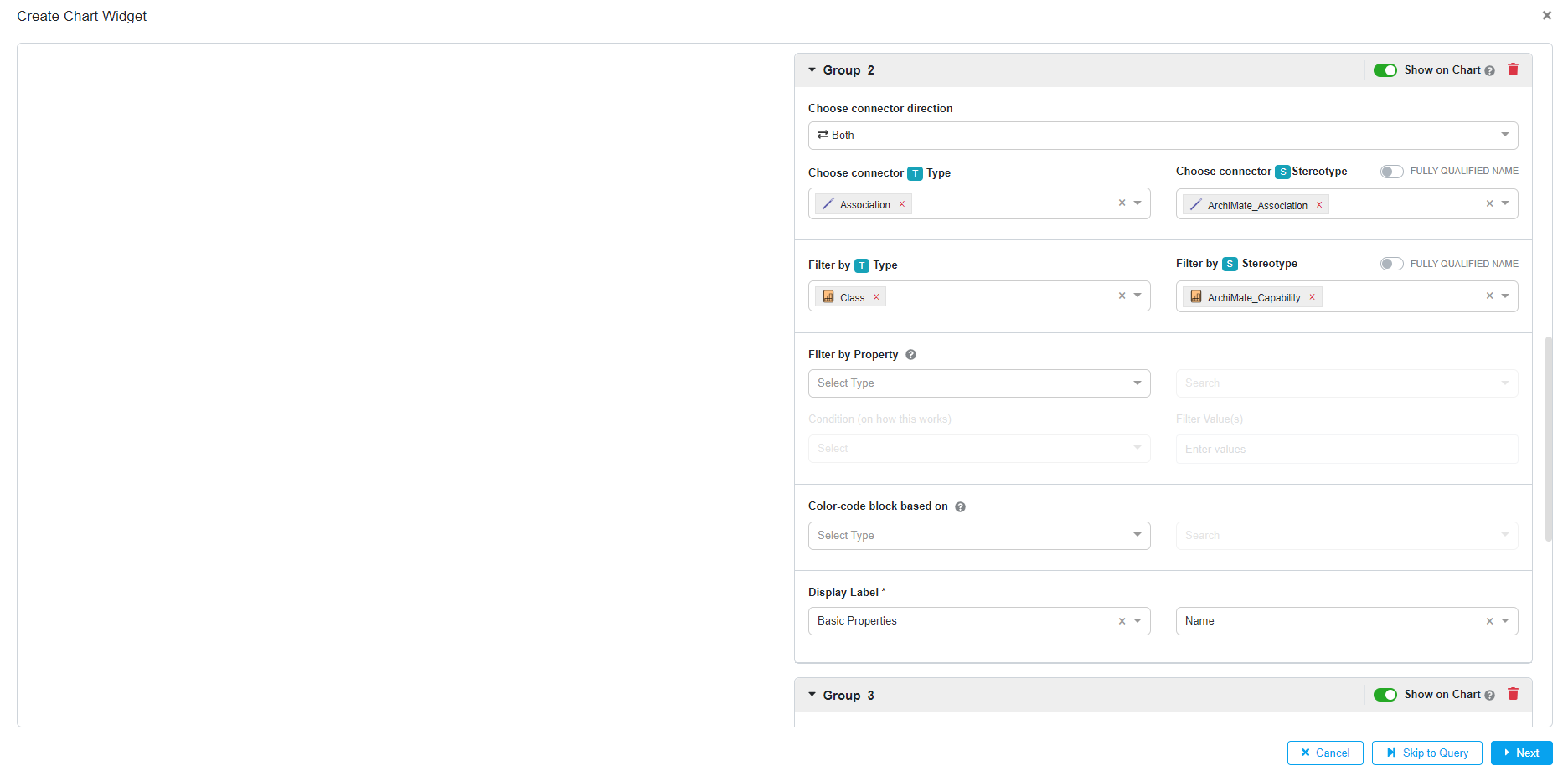
After choosing all the filters click Next.
On the query configuration page, the queries for the designer configuration will be displayed. Users can either customize the query if required by enabling the Edit auto-generated query option or copy the query and use it later for customization.
Note:
- Enabling this option will result in loss of traceability between the selected designer configuration from the previous page and the query.
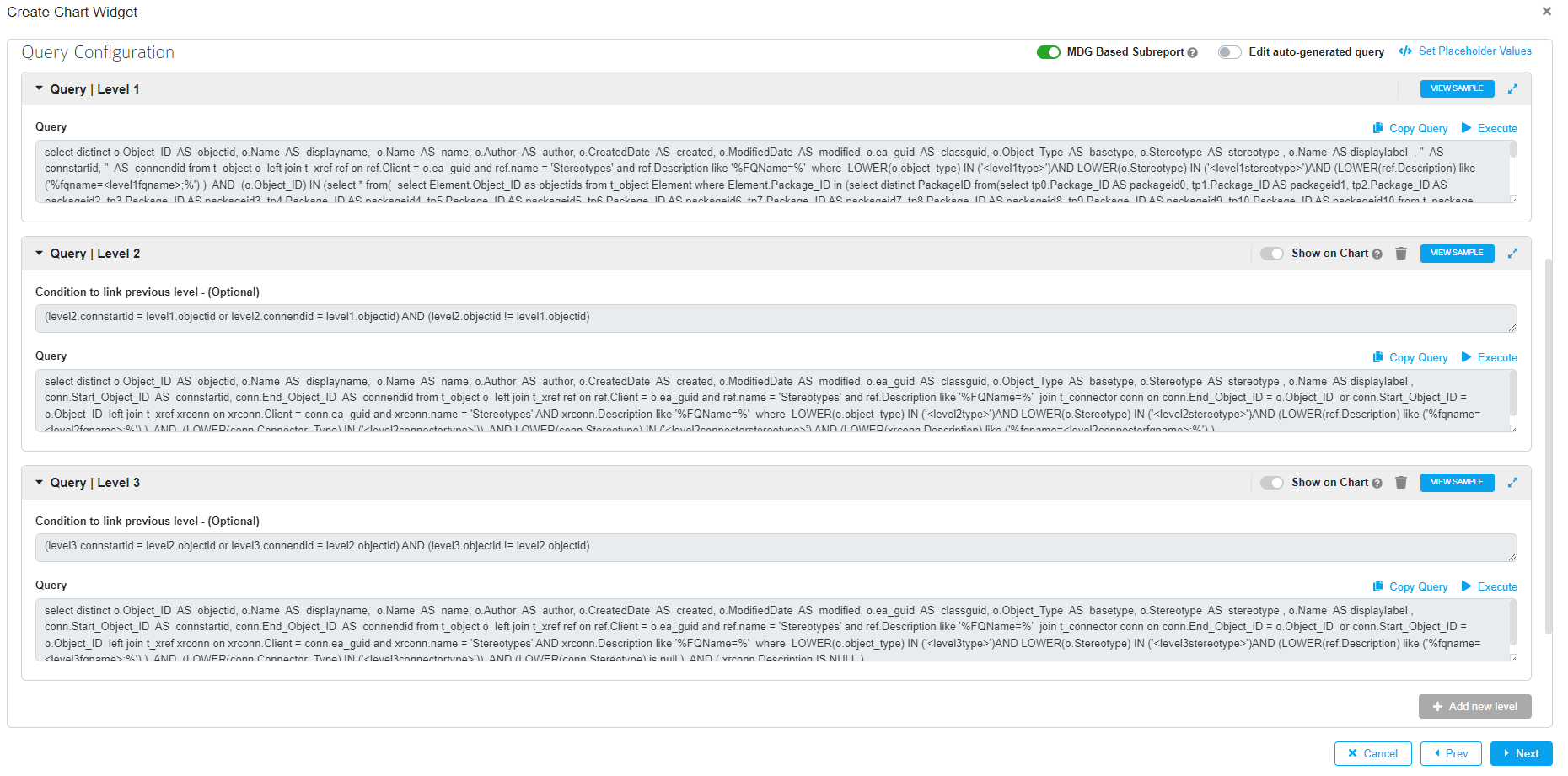
Click Next to navigate to the chart settings page.
Users can customize the style and aesthetics of the chart on the Chart Settings page. We’ll go over each feature in more detail later in this article. Now press the Save button.
Build Landscape Chart using SQL Queries
In Create Chart Widget, follow the below steps to create a Landscape chart using SQL Queries.Basic Details
| Field | Description |
|---|---|
| Chart Name | Enter a suitable chart name |
| Choose Chart Type | Choose Landscape under chart type |
Click Skip to Query option to go straight to the Query Configuration and build the chart by following the below steps.
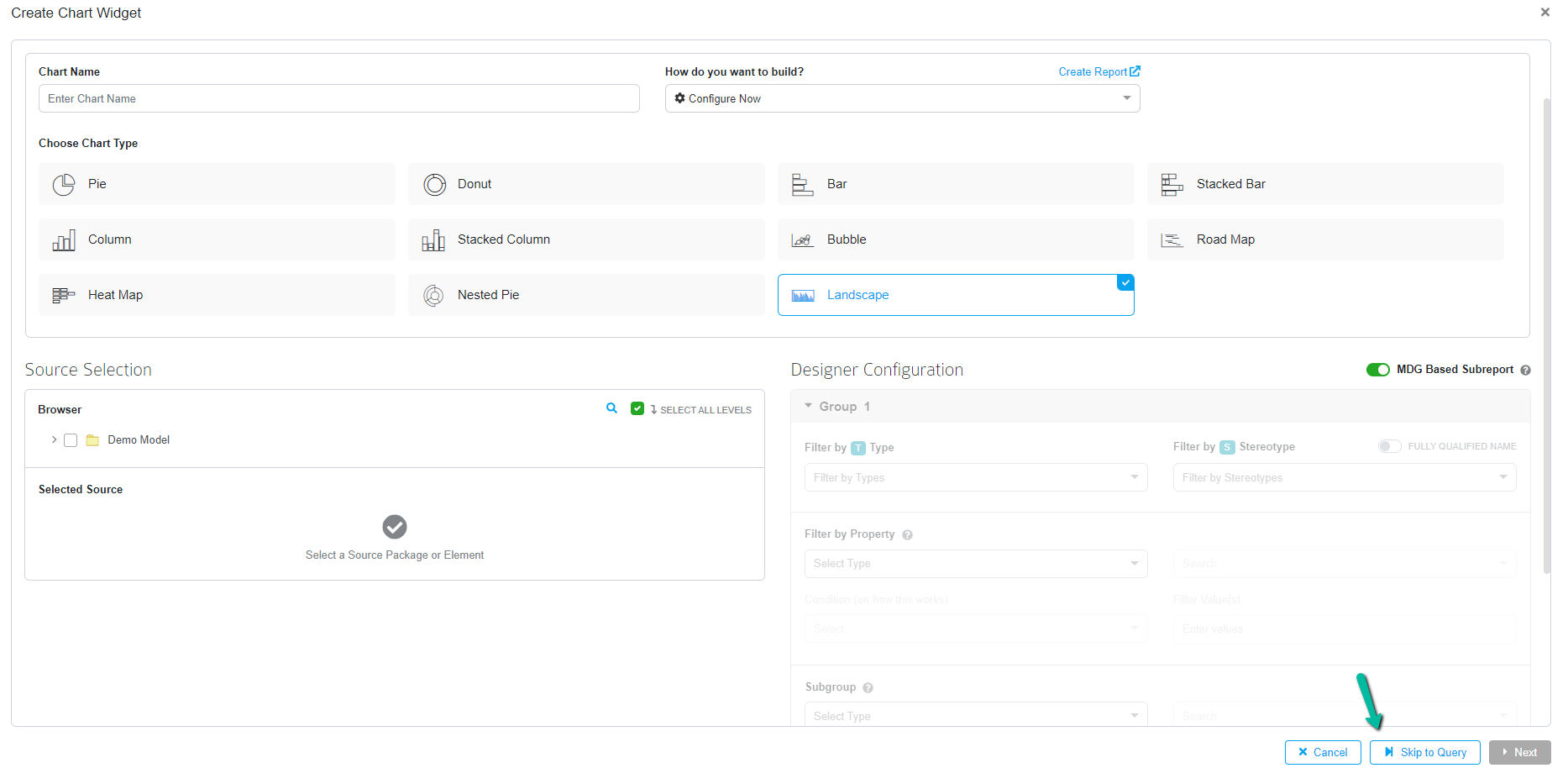
Query Configuration
This section captures the query required to create the Landscape chart.
| Field | Description |
|---|---|
| View Sample | It displays a sample query with the option to see more |
| Query | Enter the query in the space provided based on requirements |
| Copy Query | Click this button to copy the entire query, with no manual selection required |
| Execute | Click on Execute to see the query’s results |
| Condition to link previous level (In level 2 and 3) | Enter the required condition to link with the previous level |
| Show on Chart | Toggle this option to show/hide the level configured in the final output of the chart. This would come in handy when building charts with many levels and you want to control which levels need to be displayed |
| Delete | Click Delete icon to delete the level from the chart |
| MDG Based Subreport | Option enabled by default which allows users to see in-depth information when one clicks the dissections of the chart. It also allows users to filter the report data based on MDG stereotypes available. To know more, click here |
| Enable Clickable Query | By enabling this, the user can enter a clickable query and see the results when the respective section of the chart is clicked.
|
| Set Placeholder Values | Displays the list of placeholders in the query, if there is any. Enter values for the respective placeholders and save them. To know more, click here |
| Save as Report | Save the configurations applied as a report in Report Configuration page where it can be reused again when a new chart is created. To know more, click here |
| Fetch Result Query | Click this button to fetch the result query |
| Result Query | This text box will display the result query upon clicking on the Fetch Result Query. In multi-level charts, it combines the queries from all the levels to a single query |
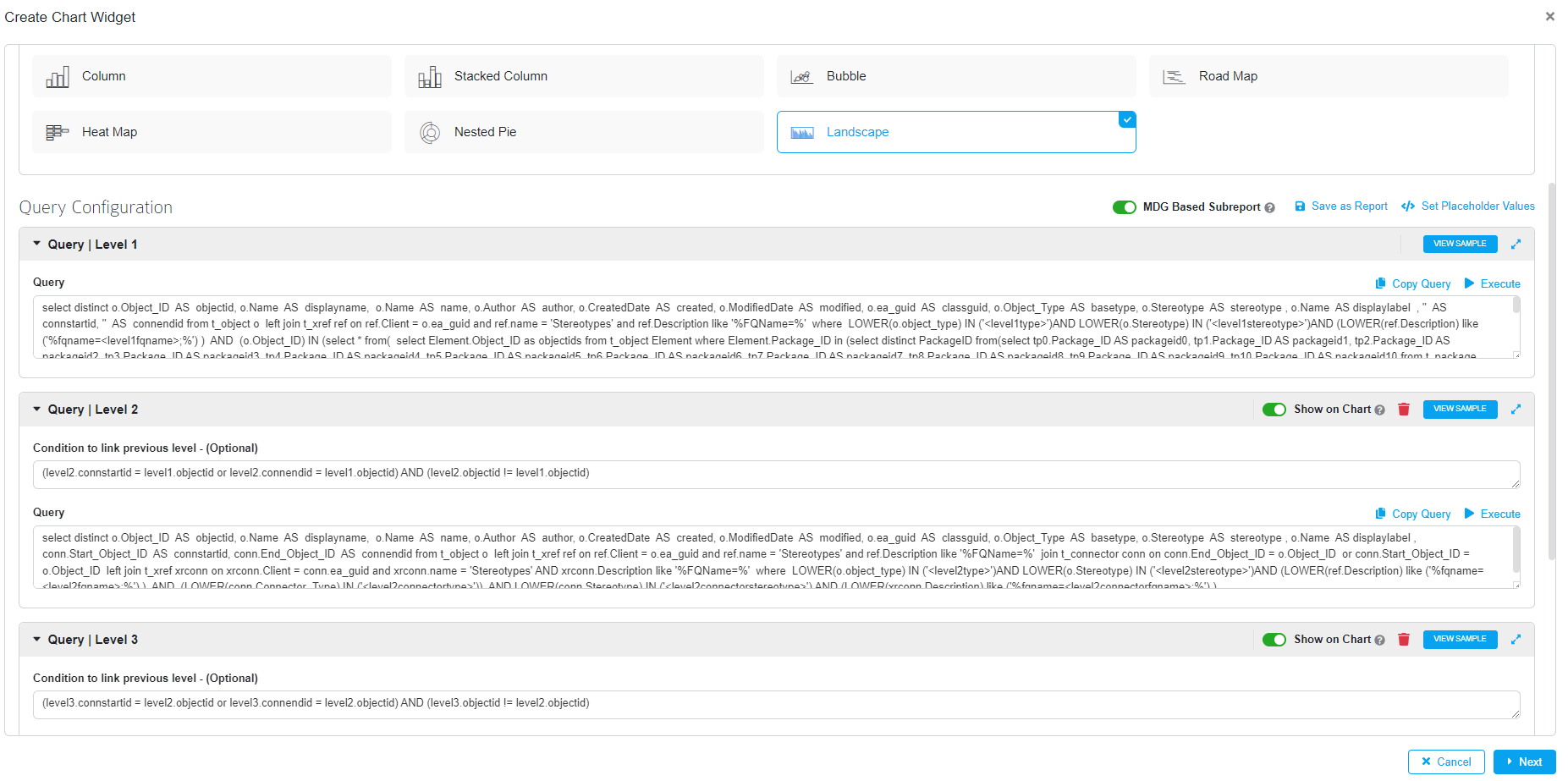
Click Next to navigate to the chart settings page.
Note:
- To apply colors for individual tagged values that are defined using Color Palette Configuration, an alias ‘seriesproperty’ should be mentioned in the query
- To apply colors for individual tagged values in a subgroup, an alias ‘groupnameproperty’ should be mentioned in the query
Users can customize the style and aesthetics of the chart on the Chart Settings page. We’ll go over each feature in more detail later in this article. Now press the Save button.
Build Landscape Chart using Reports
From Prolaborate V4.2.0 and above, charts can be created by using predefined and reusable reports from Report Configuration. To know more about Report Configuration, click here
The created reports from report configuration window can be applied when creating a new chart widget. After choosing the widget type, a popup will appear listing all the available reports.
For EA chart widget, it will display only the query type reports. The level column denotes the number of levels configured in the report.

Report can also be selected by selecting Choose a Report from the dropdown How do you want to build? option.

After selecting the report, choose the required chart type. The configuration will be automatically applied and then click Next to navigate to the chart settings page.
If the selected report contains configurations of more than one level, then only the multi-level charts of type (Heat Map, Nested Pie, Landscape) will be available for selection.

Users can customize the style and aesthetics of the chart on the Chart Settings page. We’ll go over each feature in more detail later in this article. Now press the Save button.
Customize Landscape Chart
Chart Preview: This section will show a preview of the chart after the changes have been applied to it.
Refresh Chart Preview: This feature allows you to see a preview of the changes made in the chart settings on the current page. Changes made in the chart settings will be reflected in Chart Preview.
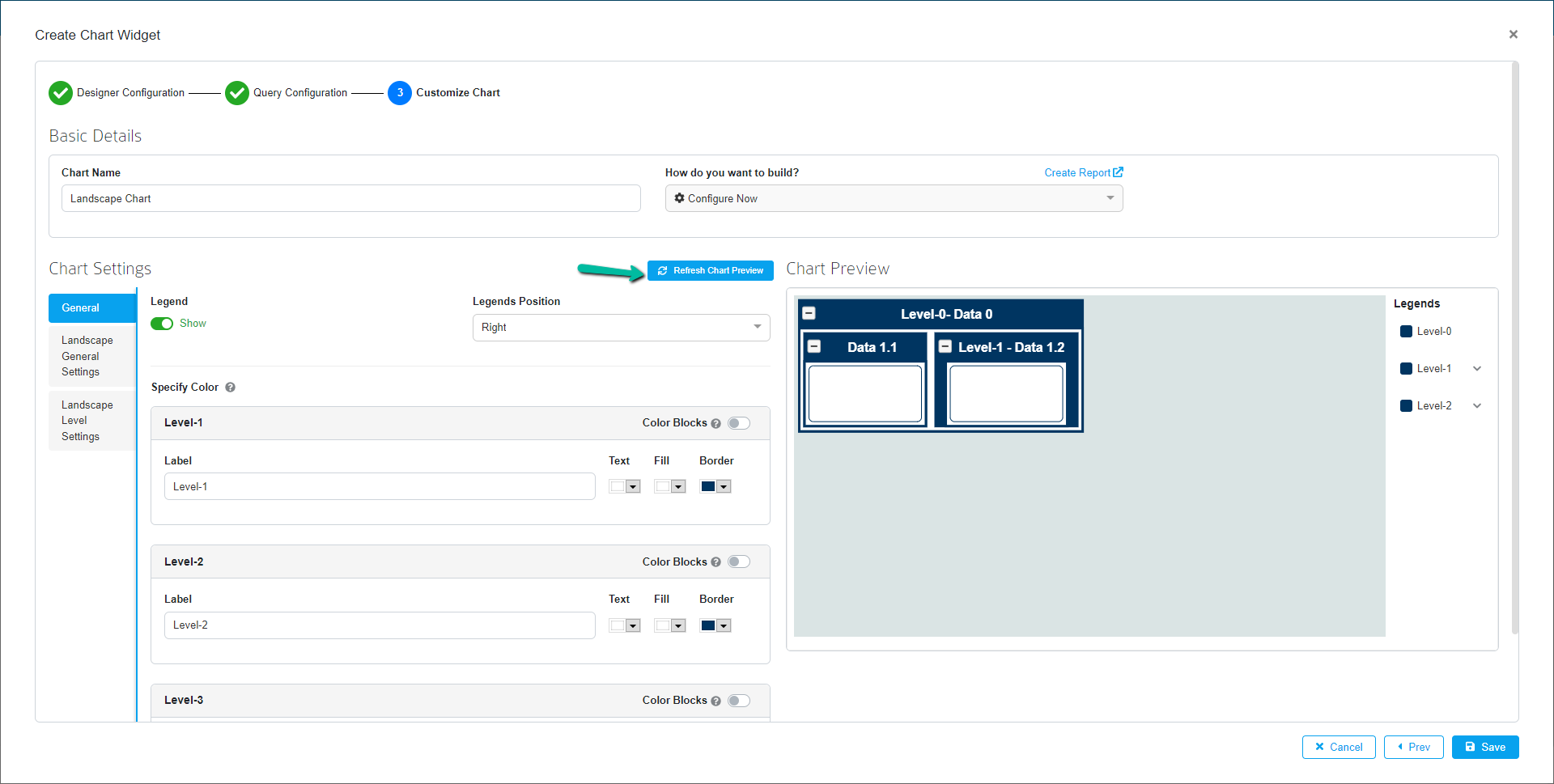
General
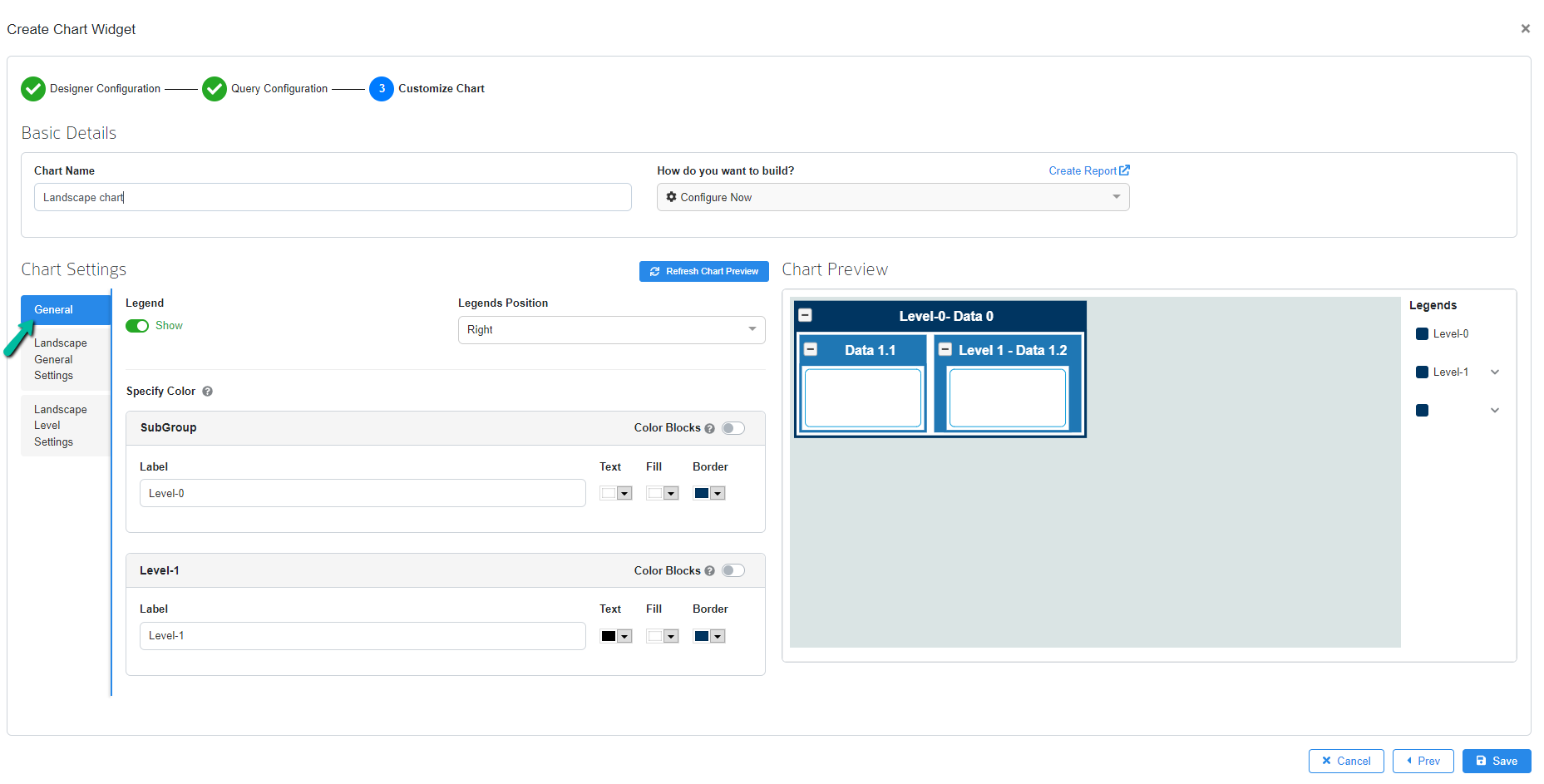
Under General section, users can modify the general chart settings based on their needs.
| Field | Description |
|---|---|
| Legend | Toggling this option will allow the users to show or hide the legend in the chart |
| Legends Position | By using this feature, users can place the legend either on the bottom or on the right side of the chart area |
| Specify Color | Apply color to highlight a section of the chart based on the data it represents |
| Level | Specify Label and text color and fill color, Border color for subgroup items by using this option |
| Color Blocks | Enable this option to apply colors to a section of the chart either from Color Palette or MDG Color Configuration |
Landscape General Settings
Landscape settings allow you to change the layout style, border width, fit to Screen, Animation onHover-Last Level, Animation onHover-Levels Above, Group expand by default etc. Under Chart Settings, you can select Landscape Settings.
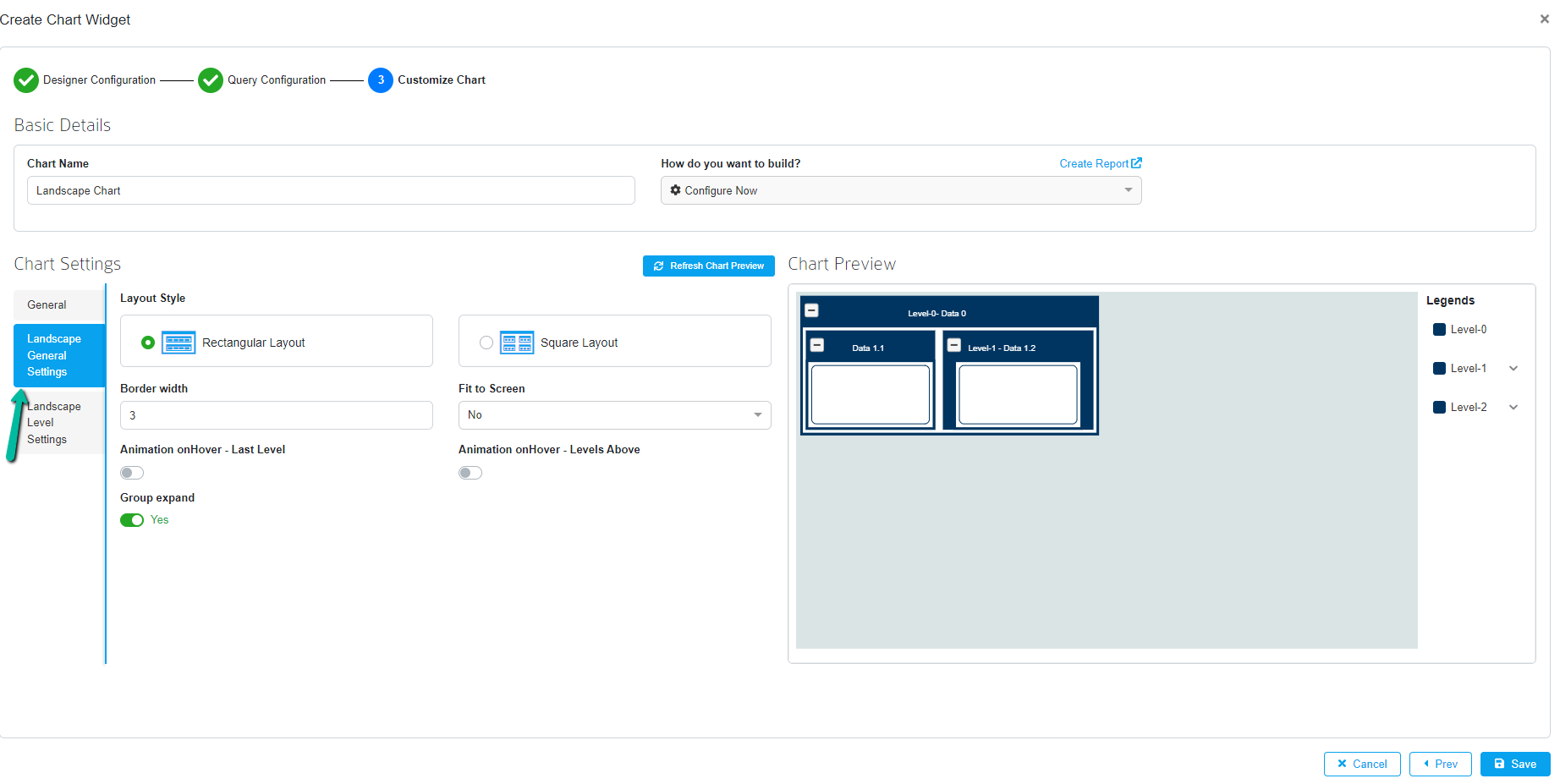
| Field | Description |
|---|---|
| Layout Style | Specify the layout style by choosing the layouts from the list |
| Border width | By changing the value, users can increase or decrease the border width |
| Fit to Screen | Specify the chart fit to the screen by default |
| Animation onHover- Last Level | When hovering the chart user can see animation effects to their objects in last level |
| Animation onHover- Levels Above | When hovering the chart user can see animation effects to their objects in the parent level |
| Group Expand | If this option is enabled all the levels which is show in a expanded structure to the users |
Landscape Level Settings
Landscape settings allow you to change the font styles and font size for all the levels in the chart, arranging Groups based on number of columns etc. Under Chart Settings, you can select Landscape Settings.
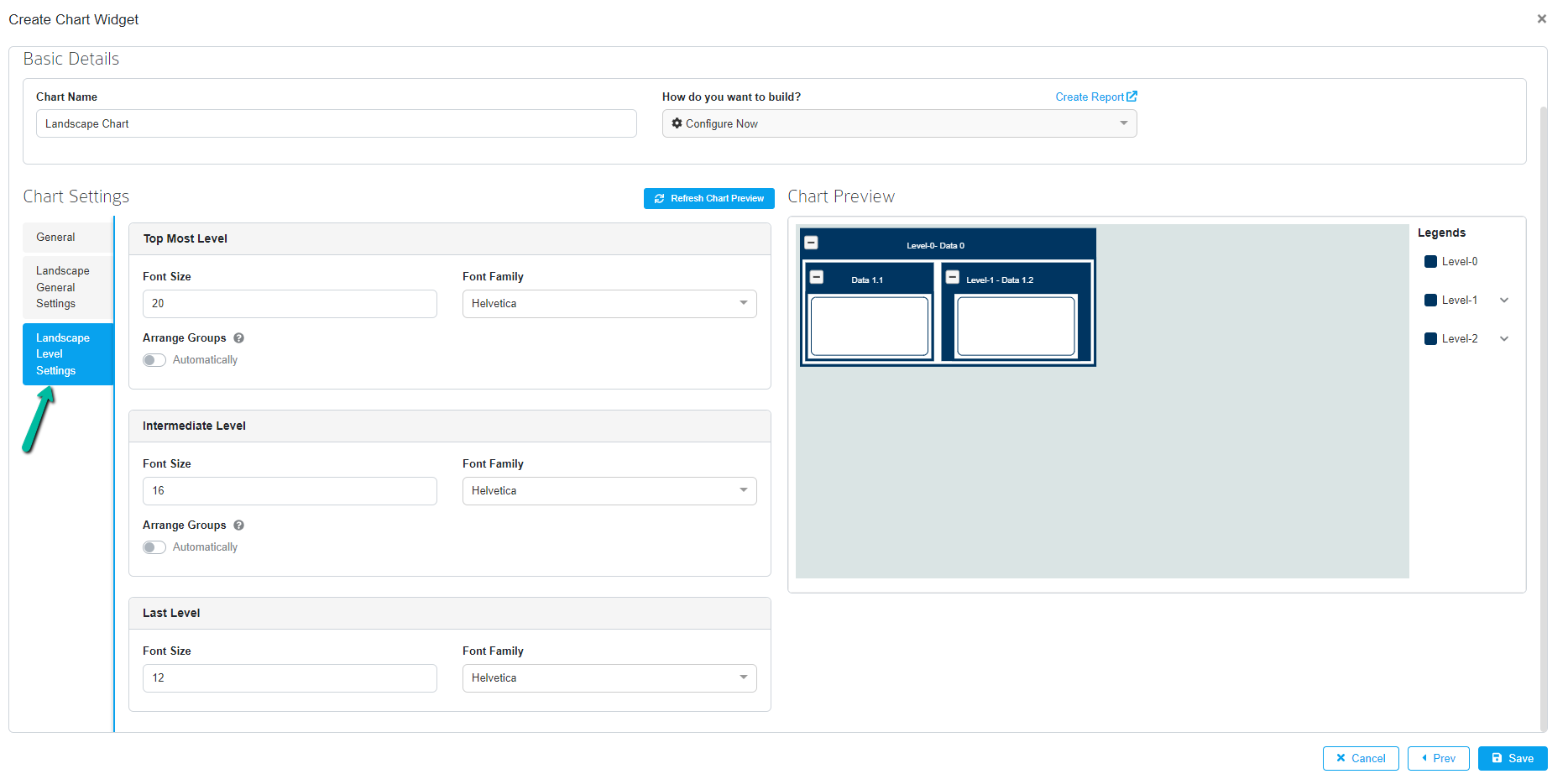
| Field | Description |
|---|---|
| Font Family | Select the font to be applied for the chart’s text and numbers. Select the desired font for the text and numbers by clicking the dropdown |
| Font Size | Specify the font size that will be used for the chart’s text and numbers. Select the desired font size for the text and numbers by clicking the dropdown. |
| Arrange Groups | Enable this option to arrange the blocks in groups based on the layout with option to enter the number of columns to be grouped. |
Click Save to save all the configurations.
After clicking save, users can change the size of the widget on the following page by clicking on the bottom right corner of the widget. After resizing the widget’s size, click Save.
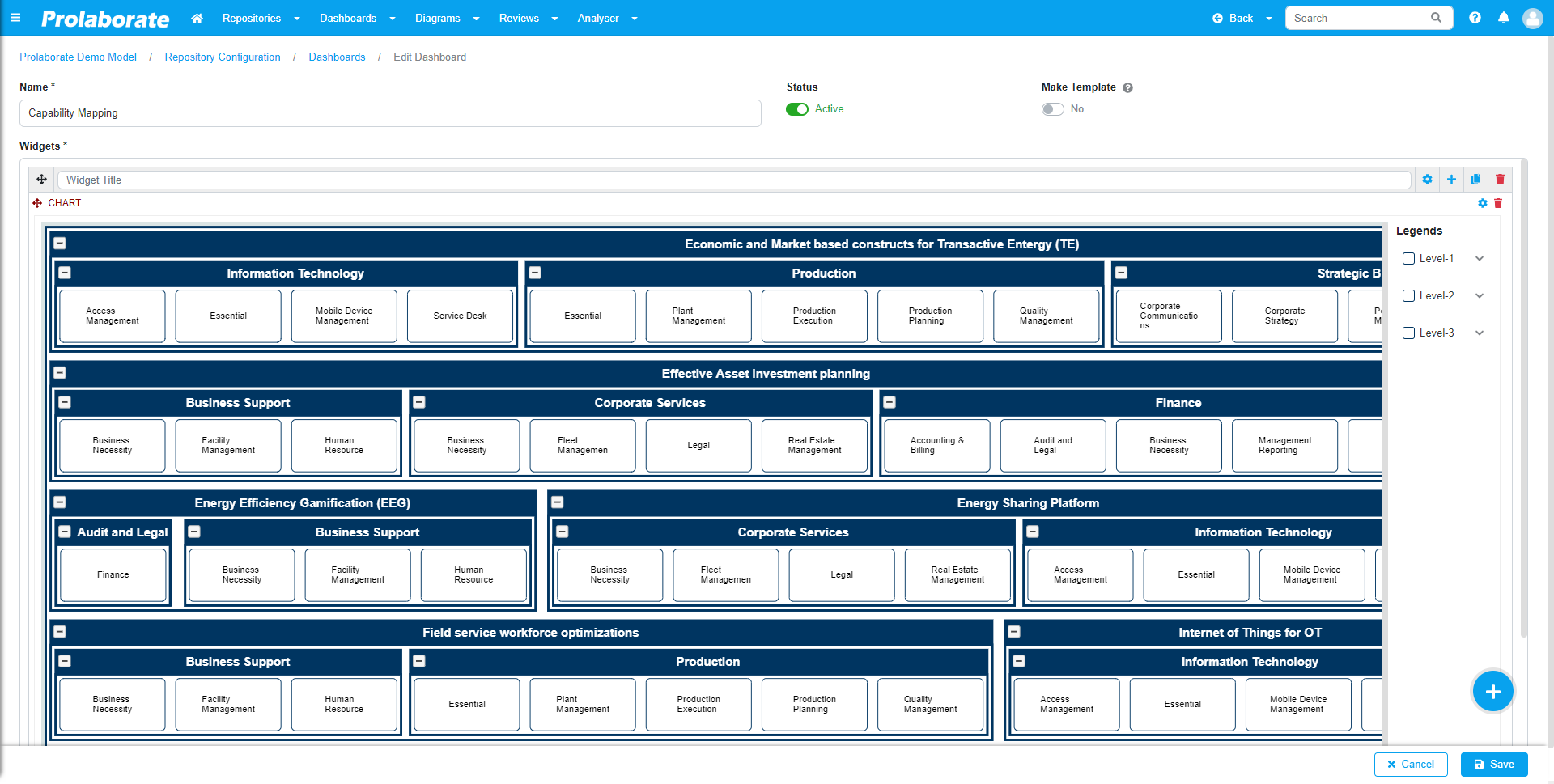
The Landscape chart has been successfully configured and is now visible on the dashboard page.
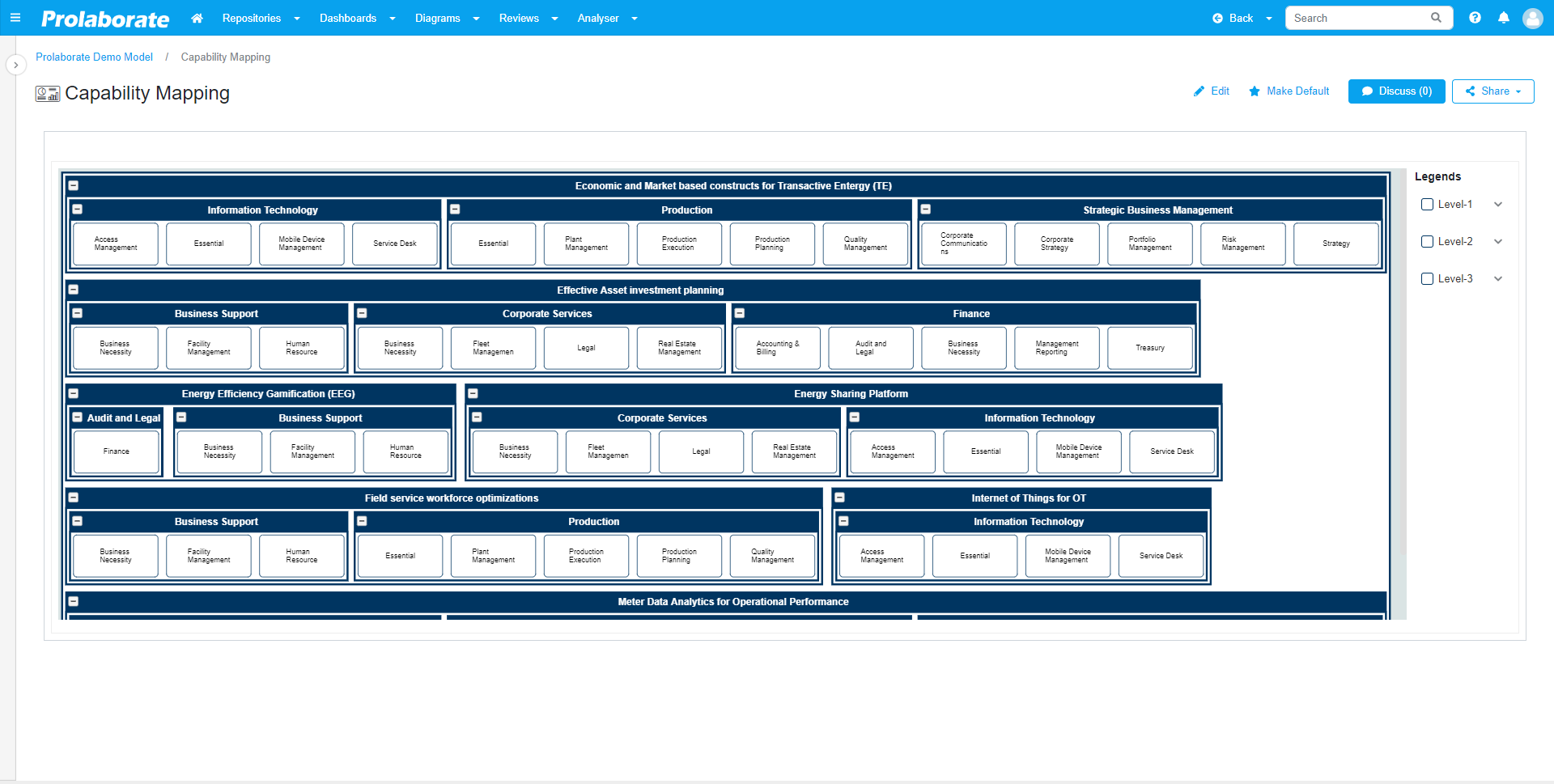
Landscape Chart Widget Options
Once the chart widget is created, multiple options will be displayed when hovering on it.
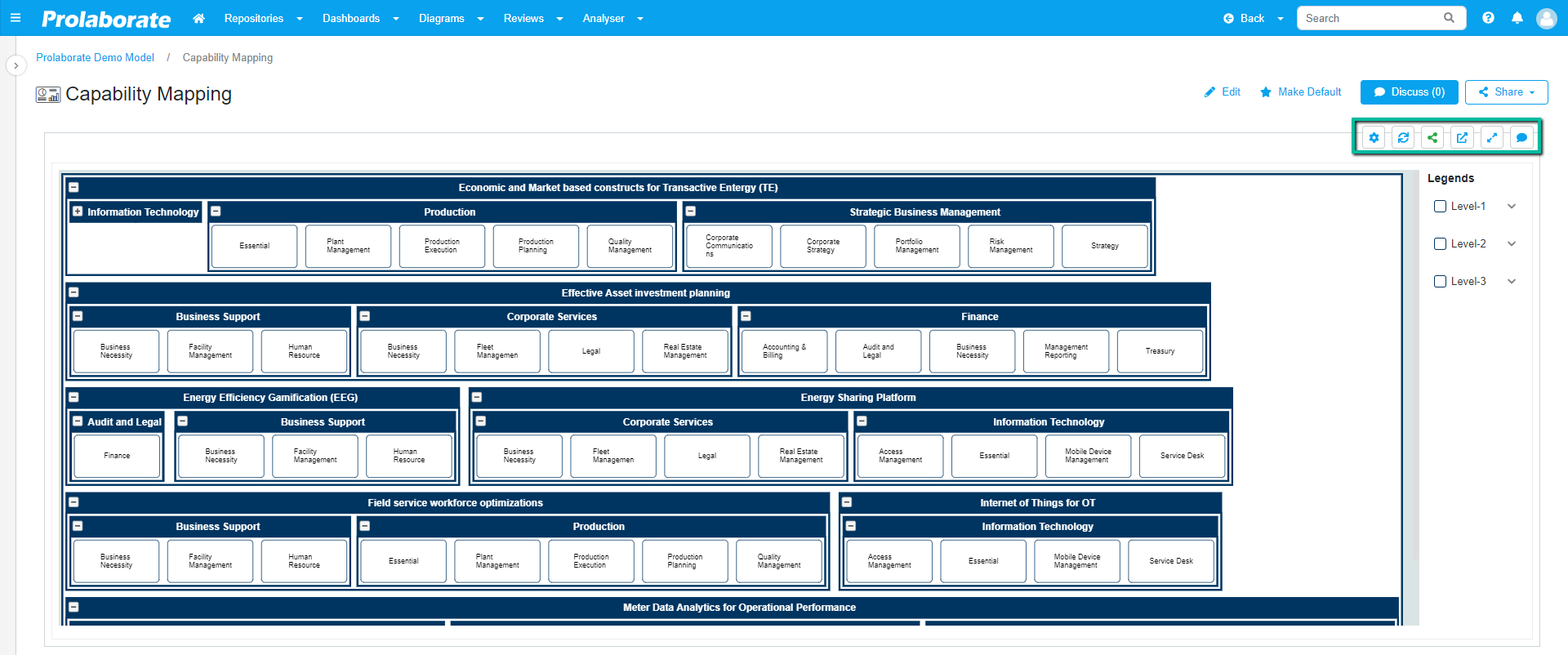
Chart Settings
Chart Settings in the widget displays a list of option where users can temporarily modify the look of the chart, download or print the chart, etc.
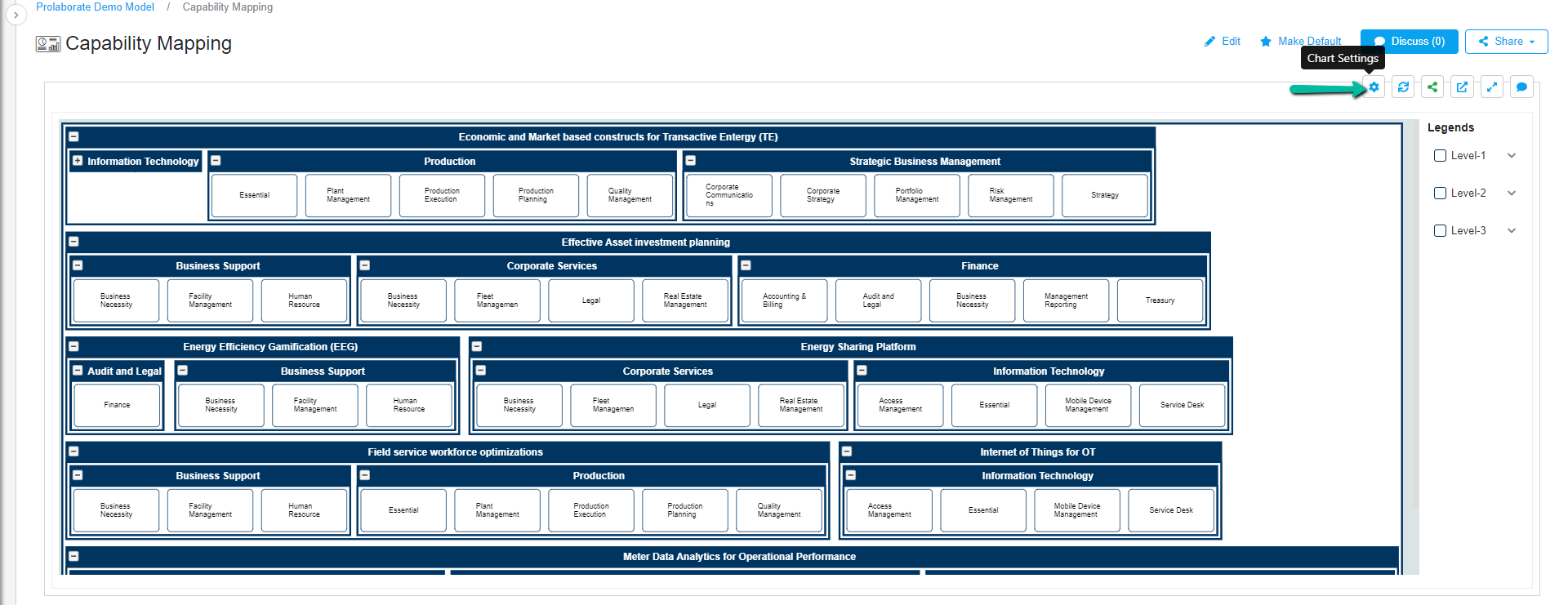
Show/Hide Legend
This option allows users to show/hide the legends in the chart widget.
Modify View
Modify view option opens the chart settings popup window where users can modify the look and aesthetics of the chart temporarily. This helps users to test the various changes before applying them permanently.
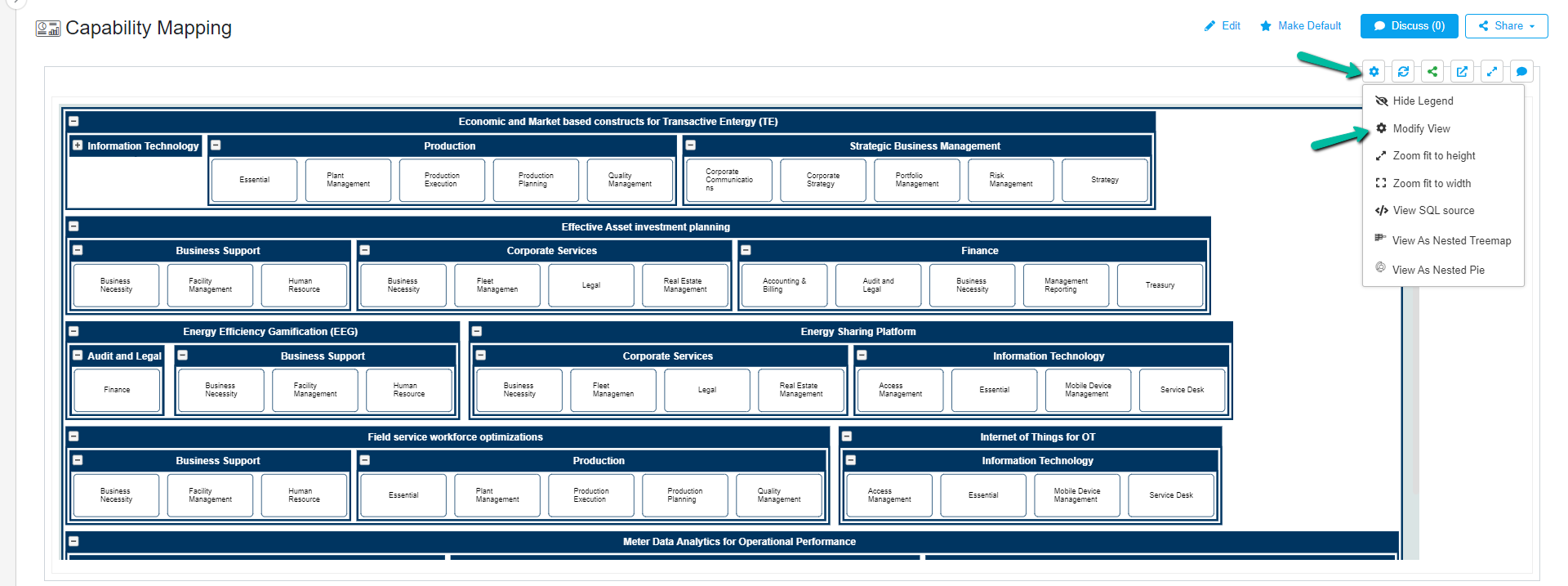
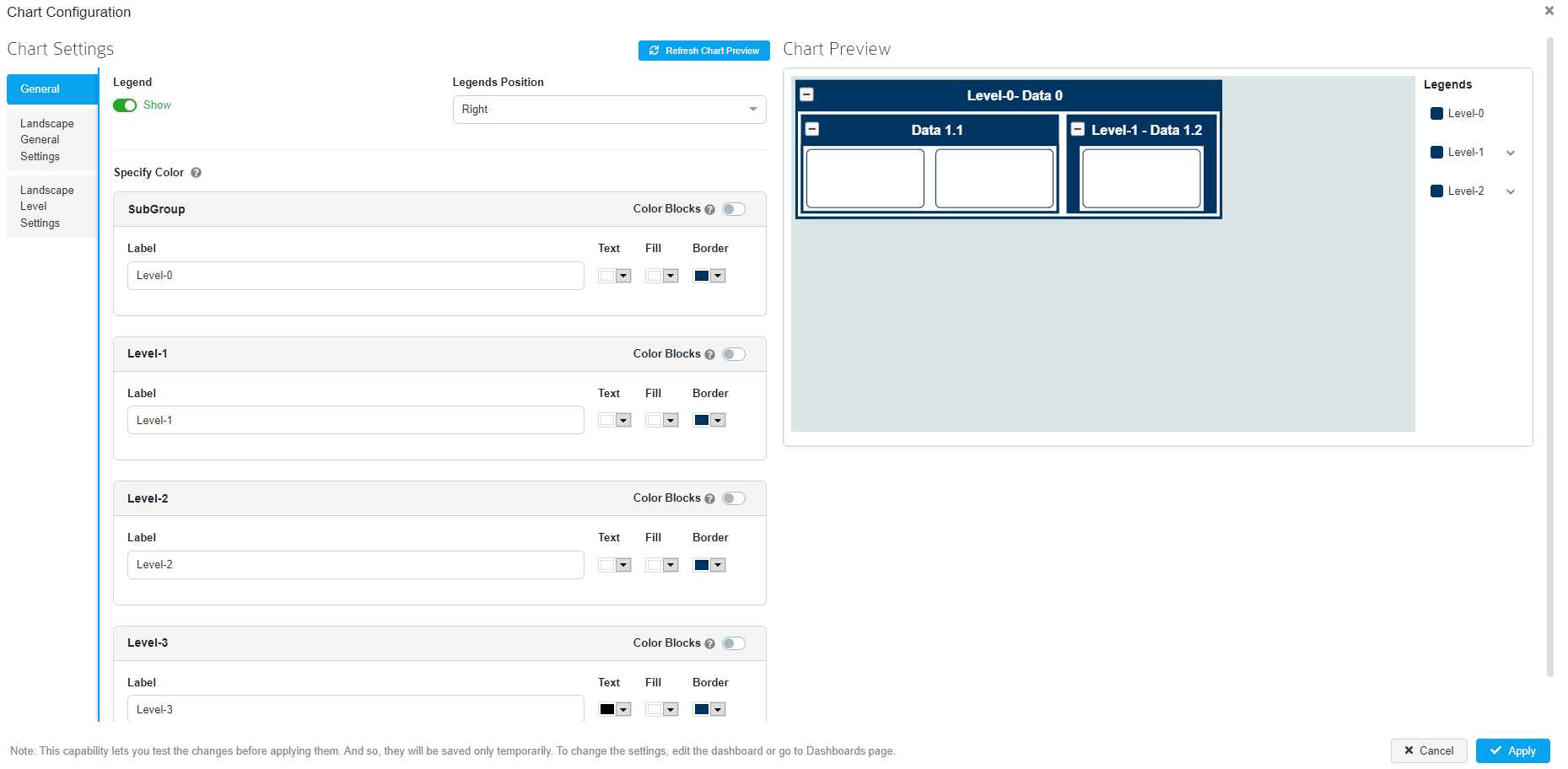
View as Heat Map
This option temporarily changes the output of the landscape chart to a heatmap chart.
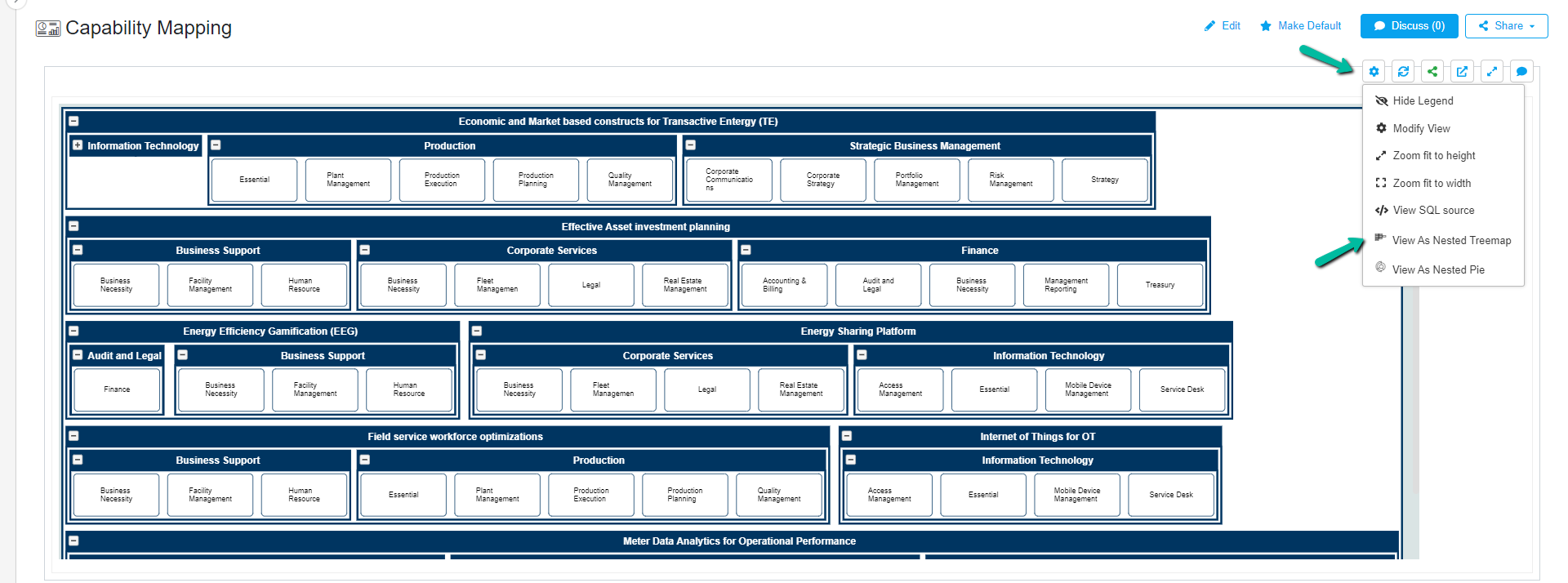
View as Nested Pie
This option temporarily changes the output of the nested pie chart to a nested pie chart.
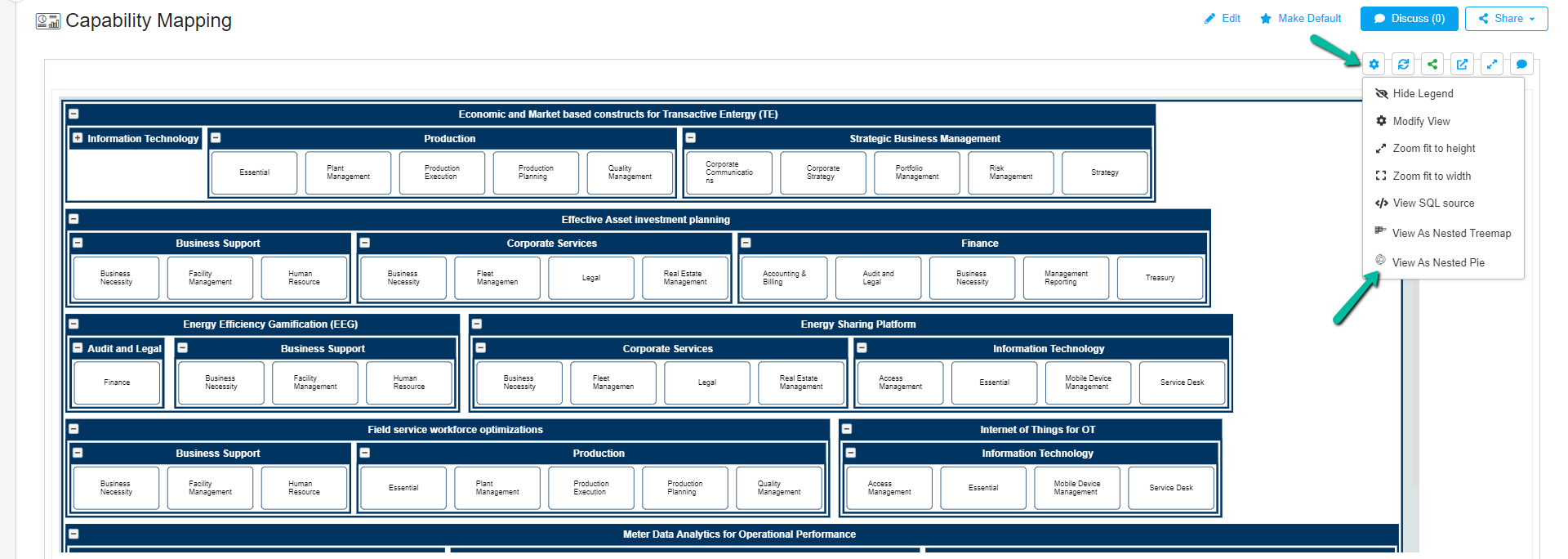
View as SQL Source
This option shows the source SQL query of the configured landscape chart.
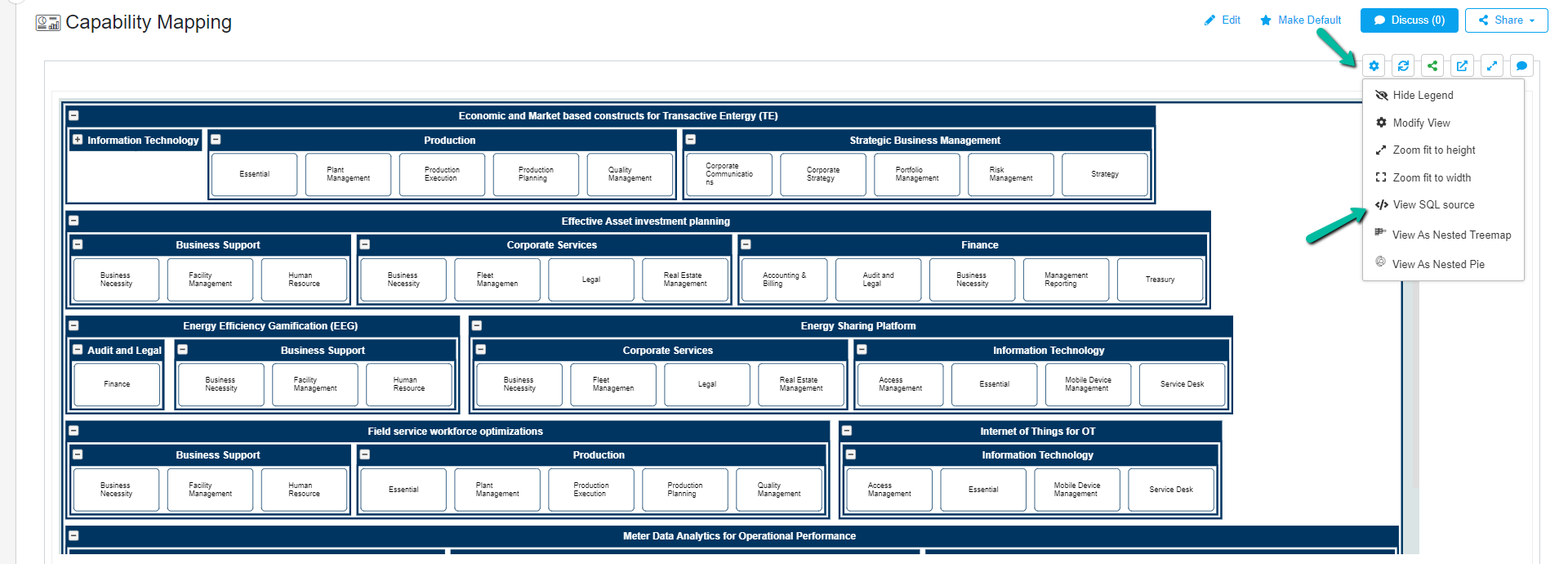
Share Widget
To share a widget, hover over a widget and click on the Share icon in the widget. Under the Copy Link to Share dropdown, select the type of link (Public, Private or Embed) to be shared.
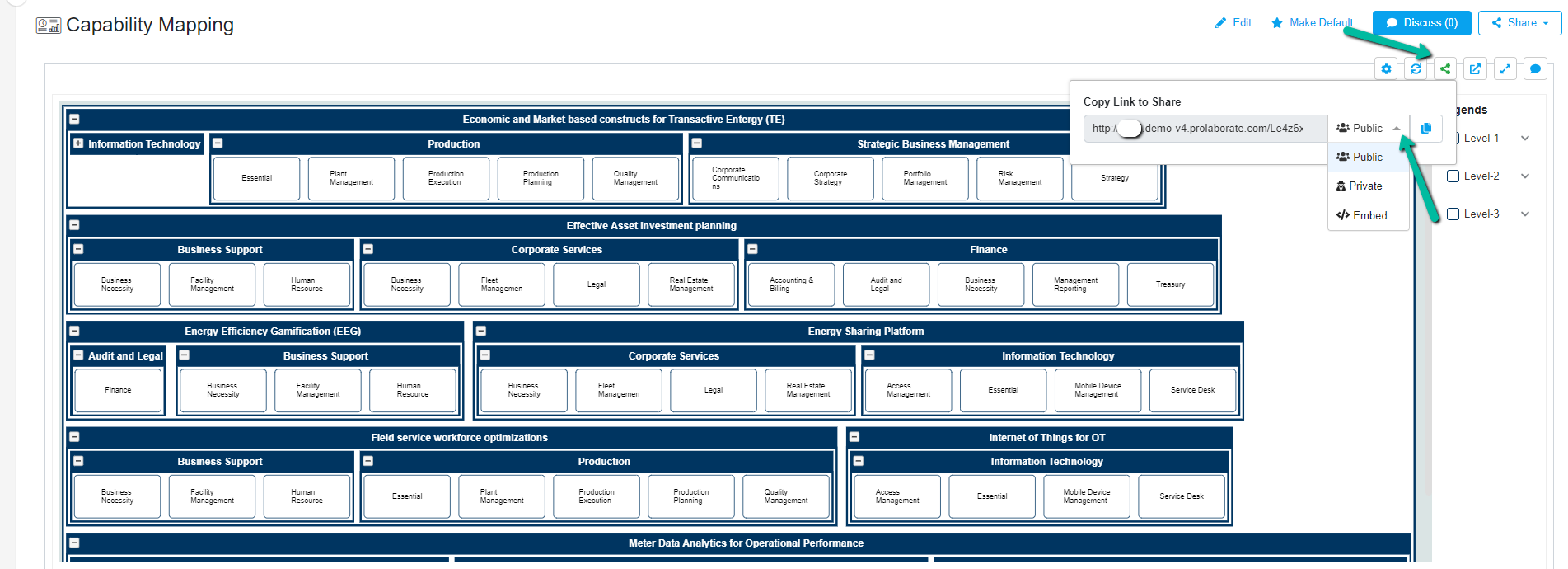
Discuss Widget
Discussions can be initiated for a selected widget in the dashboard. To discuss, hover over a widget and click the Discuss icon to open the discussion tab to start a discussion.
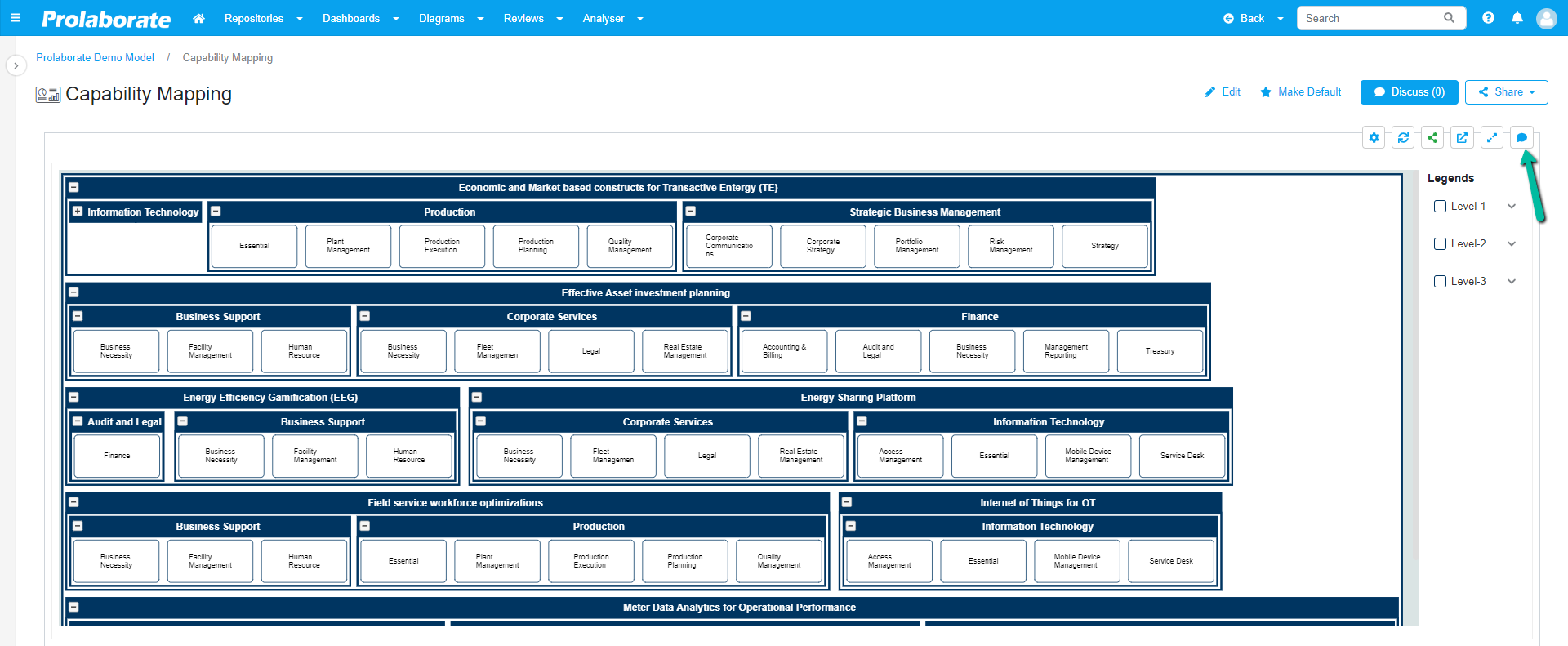
The other options in the widget includes refresh, view and maximize or minimize the widget respectively.




